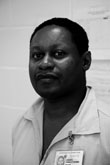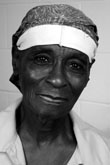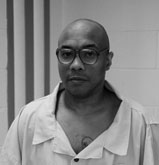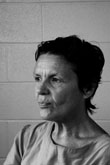8 inmates tell their stories
During the week of August 30 thru September 3, 2010, Alan Pogue, an award-winning photographer from Austin, Texas (http://www.documentaryphotographs.com/), and Tammie Pope, the paralegal and primary investigator on this case, traveled to five institutions and interviewed 22 inmates. During these sessions, the inmates' interviews were recorded, and they were photographed. Ms. Pope also has conducted hundreds of inmate interviews over the past 20 years. Below are some of their stories.

No mattress, no blanket, no clothes, no pillow, a concrete slab, air conditioning blowing full blast and it's the middle of January. And they think that's going to help you somehow."
Gary suffers from paranoid schizophrenia along with arthritis in both hips. He spent time at Perry Correctional Institution as well as Gilliam Psychiatric Hospital, the corrections department's acute care facility after an episode at Lee Correctional Institution. The mental disorder causes him to see what's not there, hear what others don't, and act out unthinkable behaviors.
"Finally I started hearing stuff in my head and decided I had to knock my front teeth out somehow. Well, the best way to do that would be to fall flat on my face. So let's try it out. Gary, stop doing that, stop doing that. That's the cop at the door. Finally, I succeeded, blood everywhere, you know."
Listen to this Quicktime file. Read the transcript

In his mind's eye, John sees himself place the blade to his skin. The blade rips through, courses past the inner flesh into the tissue, eventually coming to rest against a muscle. He is what's known as a cutter, inflicting numerous self injuries during his years in prison.
"I'm sitting there, I get a glazed-over look in my eye, and it's like I'm gone. Not necessarily out of body, but like a trance. In my mind's eye I see myself do it and after that that's it. It's done from that point on. An hour later, maybe 15 minutes later after I got the trance and have accepted it in my mind, what I'm going to do. I know what I'm going to see."
Listen to this Quicktime file. Read the transcript

It was difficult for Maree's daughter to see her aging mom in prison. Diagnosed with schizoaffective disorder, Maree, in her 70s, suffers from loneliness and depression. "Well, I get blue sometimes, and I get depressed and I cry a lot and I had some nasty things did to me." Visits from her granddaughter kept her going. Then one day she had a special visitor. "I'm telling you, a million dollar right in my hand.
Listen to this Quicktime file. Read the transcript

Fear engulfs Paul. He suffers from agoraphobia, post-traumatic stress disorder, depression, and anxiety disorder. Access to the medications he needs is limited, and he lacks control of his environment, which creates anxiety. "It's not just the suffering, I want to function better. I want to be able to have a quality of life. And I can't do that if I can't leave my cell. My illness makes it impossible to do that if it's not treated adequately."
Listen to this Quicktime file. Read the transcript

Russell cuts himself to get the frustration out. Housed in solitary confinement, his crisis intervention involves being locked in a shower, handcuffed, for up to 72 hours. Medications help him think more clearly. "They don't give me my Prozac or my Seroquel or the medicine I've been taking to help me rest or help me think a little clearer. They stopped giving it to me. That's what makes me get more hyper, more want to hurt myself when I could get that medicine that will control some of my behavior sometime."
Listen to this Quicktime file. Read the transcript

Sometimes the voices in her head are scary. They tell her to kill herself. "It ain't worth you living." Shirley suffers from depression and auditory hallucinations. When she was housed at Camille Graham Correctional Institution, she went through crisis intervention. "No, I don't like being on crisis because I don't like being naked. And that's what it is basically, you're naked and you ain't got nothing but that little green shield, whatever they call it, for clothing and to be cold. It be cold down there on crisis."
Listen to this Quicktime file. Read the transcript

He was abusive. She killed him.
Diagnosed with schizoaffective disorder and personality disorder, Wanda relives the events leading up to her crime – and the crime itself – over and over, during the day, into the night, into her dreams.
"When my anxiety gets really bad, I can't stand a lot of noise. I go back to that room and close the door. And the pattern I go through to calm myself down is I brush my hair, drink water, sit there and try to mentally calm myself down. I always seem to want an object in my mouth, I need an object. It's like an impulse. I've got to have it. A spoon, a pencil cap, it helps to keep me thinking."
Listen to this Quicktime file. Read the transcript